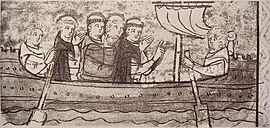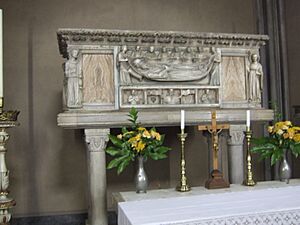Odoric of Pordenone facts for kids
Quick facts for kids Blessed Odoric of Pordenone |
|
|---|---|

The departure of Odoric
|
|
| Born | 1286 Pordenone, Patriarchate of Aquileia, Holy Roman Empire |
| Died | January 14, 1331 (aged 44–45) Udine, Patriarchate of Aquileia, Holy Roman Empire |
| Venerated in | Roman Catholicism (Franciscan Order) |
| Beatified | 2 July 1755, Saint Peter's Basilica, Papal States by Pope Benedict XIV |
| Major shrine | Church of Our Lady of Mount Carmel, Udine, Italy |
| Feast | January 14 |
Odoric of Pordenone (1286–1331) was an Italian Franciscan friar and explorer. He was also known as Odorico Mattiussi or Odoricus of Friuli. Odoric traveled widely through India, the Greater Sunda Islands, and China. He spent three years in Beijing. After his death, many people honored him. He was officially declared "Blessed" in 1755.
Odoric wrote about his journeys. His writings are still available in Latin, French, and Italian. They give good descriptions of Asian customs and religions. His travel stories were an important source for the famous book by John Mandeville. Many of Mandeville's amazing tales came from Odoric's real-life experiences.
Contents
Odoric's Early Life and Journey
Odoric was born around 1286 in Villanova, a small village near Pordenone in Friuli, Italy. His family, the Mattiussi, helped defend Pordenone.
When he was young, Odoric joined the Franciscan order. He lived in their monastery in Udine. In 1296, Odoric became a missionary. He traveled to the Balkans and then to the Mongols in southern Russia.
Starting His Big Adventure
Odoric began his main journey to the East in April 1318. He started from Padua, Italy. He traveled through Venice to Constantinople, then crossed the Black Sea to Trabzon. From there, he went through Armenia, Media, and Persia. Franciscans had mission centers in all these areas.

Odoric visited places like Sultanieh, Kashan, Yazd, Persepolis, Shiraz, and Baghdad. He then reached the Persian Gulf. With another friar, James of Ireland, he sailed from Ormus to India. They landed at Thane, near Mumbai.
Travels in India
In Thane, four Franciscan companions of St Thomas of Tolentino had recently been killed. They were martyred for their faith. Their remains were collected by Jordan of Severac, a Dominican friar. Jordan buried them in a church near Vasai. Odoric later dug up these holy remains and carried them with him.
From Thane, Odoric traveled down the Malabar coast. He stopped at Kodungallur and Quilon. He then went around Cape Comorin to the Coromandel Coast. Here, he visited the Church of St. Thomas. He also visited Puri. He wrote one of the first Western accounts of the Chariot Festival of the Hindu God Jagannath. He described how people put "idols" on chariots. The King, Queen, and all the people pulled them with songs and music.
Journey to Southeast Asia and China
From India, Odoric sailed on a junk ship to Sumatra. He visited several ports on the northern coast of the island. Then he went to Java, Borneo, and Champa. He also visited Great Nicobar Island. Some records suggest he might have visited Brunei in 1325.
He traveled from Ceylon to Guangzhou (which he called "Chin-Kalan"). From Guangzhou, he went overland to the big port of Quanzhou ("Zayton"). There were two Franciscan houses there. He left most of the remains of the Four Martyrs of Thane at one of these houses. However, he kept St Thomas's head to deliver it to the Franciscans in Tolentino, his hometown.
From Fuzhou, Odoric crossed mountains into Zhejiang. He visited Hangzhou ("Cansay"). This was one of the world's largest cities at the time. Odoric, like Marco Polo and Ibn Battuta, described its amazing sights. He traveled north past Nanjing and crossed the Yangzi. Then he got on the Grand Canal and went to the home of the Great Khan (likely Yesün Temür Khan) in Khanbaliq (now Beijing).
Odoric stayed in Beijing for three years, probably from 1324 to 1327. He likely worked at one of the churches started by the Franciscan Archbishop John of Monte Corvino. He also visited Yangzhou, where the tombstone of Katarina Vilioni was found in 1951.
Return Journey
Odoric did not return to Italy until late 1329 or early 1330. We know he was in western India soon after 1321 (likely 1322). He spent three years in China between 1323 and 1328.
His return trip is not as clearly described. He traveled overland across Asia. He went through the Land of Prester John (possibly Mongolia) and then through Casan. The adventurous friar seems to have entered Tibet and perhaps even visited Lhasa. After this, he was in northern Persia, in a region he called "Millestorte," known as the Land of the Assassins (the Rudbar of Alamut). We don't have many details about his route back to Venice, but he likely passed through Tabriz. The description of his return journey is less detailed than his outward journey.
During some of his long travels, Odoric's companion was James of Ireland. Records in Udine show that James received a gift after Odoric's death. Shortly after returning, Odoric went to a Franciscan house in Padua. There, in May 1330, he told his travel stories to Friar William of Solagna, who wrote them down in Latin.
While traveling to the papal court in Avignon, Odoric became ill in Pisa. He turned back to Udine, his home province, and died there on January 14, 1331.

Odoric's Mission and Importance
Odoric's journey was not just religious; it was also a diplomatic mission. About a century earlier, the Mongols had invaded Europe. They destroyed much of Russia and attacked Poland and Hungary. Then they suddenly left.
At the First Council of Lyon in 1245, Pope Innocent IV sent the first missions to the Great Khan. These missions were given to the Franciscans. Other popes also sent Franciscans over the next century. Famous explorers like Niccolò, Matteo, and Marco Polo made two trips in 1260 and 1271. In 1294, the missionary John of Monte Corvino made a similar journey for Pope Nicholas IV. Odoric's journey was part of this important effort to connect with the Mongol Empire.
Fame of His Journeys
Odoric's amazing travels made a big impression on the people in his home region. His fellow Franciscans were going to bury him quickly and simply. But the chief magistrate of the city stepped in and arranged a public funeral. Stories of his travels and miracles after his death spread quickly across Friuli and Carniola. The funeral had to be delayed several times. Finally, it took place with the patriarch of Aquileia and other important local leaders present.
People honored him as a saint. The city built a special shrine for his body. His fame as a saint and traveler spread far and wide. However, it took four centuries, until 1755, for the Pope to officially approve his beatification. A statue of Odoric was put up in Pordenone in 1881.
What Made His Accounts Special?
Odoric's book shows he was a true and original traveler. He was the first European after Marco Polo to clearly mention the name of Sumatra. His descriptions of certain people on that island, who practiced cannibalism and shared wives, were accurate for the region. His description of sago in the islands has some errors, but they are the errors of someone who saw it firsthand.
Regarding China, he was unique among travelers of his time for mentioning Guangzhou by the name Censcolam. He also described:
- The custom of fishing with trained cormorants.
- The habit of letting fingernails grow very long.
- The compression of women's feet.
Marco Polo did not mention any of these things. Odoric was someone who not only visited many countries but also wrote about them to share his knowledge.
Beatification
Many miracles happened at Odoric's tomb. Because of this, Pope Benedict XIV approved the public honor given to Blessed Odoric in 1755. In 1881, the city of Pordenone built a beautiful memorial to their famous son.
Legacy
A minor planet, 4637 Odorico, is named after him.
Images for kids
See also
 In Spanish: Odorico de Pordenone para niños
In Spanish: Odorico de Pordenone para niños



